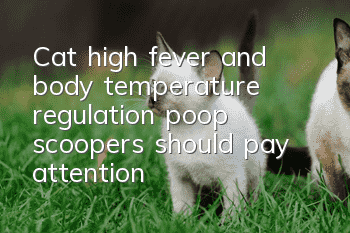Cat high fever and body temperature regulation, poop scoopers should pay attention!

It is normal for a cat’s body temperature to temporarily increase
Cats have high fever and body temperature regulation, so cat owners should pay attention! Generally speaking, a cat’s body temperature will have a fluctuation range, and the body temperature will rise within It is a normal phenomenon within a certain range, but if it exceeds a certain limit or lasts for too long, it should be taken seriously. There are many causes of high fever in cats, which need to be carefully identified by owners and doctors.
1. Types of elevated body temperature
1. True fever< /strong>
True fever refers to fever produced by endogenous pyrogens. Endogenous pyrogens are mainly cytokines, such as leukocyte intermediaries. hormones, tumor necrosis factor, interferon, etc. They are produced by using a variety of immune active cells under the stimulation of immune responses to different antigens or pathogenic factors. Cytokines have many functions such as immune regulation, stimulating hematopoiesis, anti-virus, and anti-tumor. However, the above-mentioned cytokines It also has strong pro-inflammatory activity and can act on the body temperature regulation center to cause fever in the body.
2. Insufficient heat dissipation
Insufficient heat dissipation refers to thermal shock. Shock is a stress response, which refers to the defense adaptation response characterized by changes in gene expression that a biological organism exhibits under heat stress (or other stress) conditions. This is called heat shock response. A group of proteins that are newly synthesized or increased during heat stress (or other stress) are called heat shock proteins. Heat shock response also has the basic characteristics of stress response, namely non-specificity and defense adaptability.
3. Increase in running body temperature
Exercise will also increase the cat’s body temperature. High. Generally, after the cat comes back from the outdoors, or after the cat plays and runs, the owner trains the cat, which will also temporarily increase the cat's body temperature. In other respects, pathological movements caused by cat convulsions and epilepsy can also increase body temperature.
4. Pathological or drug-induced
For example, in or around the front of the hypothalamus Injury, or some hypermetabolic diseases, as well as some external heat sources such as bacterial infections and inflammatory irritants can also increase the cat's body temperature.
2. The changing process of fever
3. Pyrogenic sources causing fever The three stages
1. Body temperature rising period
This is the early stage of fever, and the cat shows peripheral blood vessels Contraction, the skin blood flow decreases, the skin temperature decreases, and the skeletal muscles contract involuntarily due to the excitement of the shivering center, causing shivering, which causes the body temperature to continue to rise until it reaches a new set point level.
2. High temperature duration period
Also known as the extremely hot period, when cats Shivers stop, blood vessels dilate, blood flow accelerates, breathing and heartbeat rates increase, substance metabolism increases, and sometimes the high temperature can last for several days.
3. Body temperature drop period
Also known as the antipyretic period, depending on the cause of the disease The elimination of heat sources in the blood reduces or disappears, and the set point of the body temperature center returns to normal levels. At this stage, the cat's heat dissipation is enhanced, heat production is reduced, and the body temperature is lowered. The cat sweats a lot, urine output increases, and the body temperature decreases within a few days or Slowly decreases to normal levels within a few hours.
4. The relationship between the thermoregulatory control system and body temperature
The body temperature setting point is at It increases when fever begins and decreases when fever ends. When the thermoregulatory control system detects that the set point and body temperature are out of tune, it mobilizes the body's rich receptor responses to correct the mismatch. These reactions include tremors, cutaneous vasoconstriction, etc. at the beginning, and end with sweating, cutaneous vasodilation, etc.
5. Physiological mechanism of body damage caused by high fever
a) Caused by true fever Changes in the hypothalamic body temperature set point are most likely mediated by the endogenous pyrogen interleukin I;
b) Non-febrile hyperthermia does not change the hypothalamic body temperature set point;
< p>c) Sustained body core temperature >41.1℃ can lead to multiple organ damage, and core temperature reaching 42.7℃ can cause death;d) The main pathophysiological process of heat shock is related to temperature damage, including cell necrosis, Hypoxemia, protein denaturation;
e) Heat shock and its consequences can lead to SIRS.
- Diagnosis and treatment of feline viral enteritis, correct understanding of feline intestinal diseases!
- How to raise a Persian cat? How to raise a Persian cat!
- Analysis of the reasons why cats suddenly scratch people, and how to pet cats correctly?
- What causes cats to lose hair?
- Why does a kitten have blood in its stool?
- Can Chinchilla and Ragdoll cats be bred? Cat breeds!
- Can the hair on Persian cats’ ears be trimmed?
- What should cats eat to supplement calcium?
- Can a two-month-old cat be dewormed?
- What's the matter with a pimple on a cat's head?



